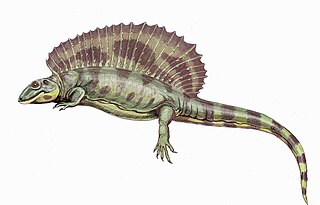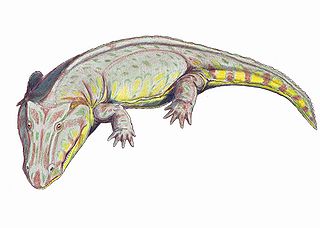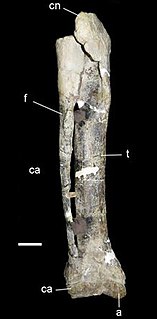 W
WAfropithecus is a genus of Miocene hominoid with the sole species Afropithecus turkanensis, which was excavated from a small site near Lake Turkana called Kalodirr in northern Kenya in 1986 and named by Richard Leakey and Meave Leakey. The estimated age of Afropithecus is between 16 and 18 million years old, which was determined with radiometric dating techniques and the geological studies conducted by Broschetto and Brown from the University of Utah. In total there are 46 recovered specimens from Kalodirr relating to Afropithecus consisting of cranial, mandible, dentition and post-cranial remains. The type specimen of Afropithecus turkanensis is KNM-WK 16999.
 W
WArchosauriformes is a clade of diapsid reptiles that developed from archosauromorph ancestors some time in the Late Permian. It was defined by Jacques Gauthier (1994) as the clade stemming from the last common ancestor of Proterosuchidae and Archosauria (the group that contains crocodiles, pterosaurs and dinosaurs ; Phil Senter defined it as the most exclusive clade containing Proterosuchus and Archosauria.
 W
WAvaceratops is a genus of small herbivorous ceratopsian dinosaurs which lived during the late Campanian during the Late Cretaceous Period in what are now the Northwest United States. Most fossils come from the Judith River Formation.
 W
WAxelrodichthys is an extinct genus of mawsoniid coelacanth from the Cretaceous of Africa, North and South America, and Europe. Several species are known, the remains of which were discovered in the Lower Cretaceous (Aptian-Albian) of Brazil, North Africa, and possibly Mexico, as well as in the Upper Cretaceous of Morocco (Cenomanian), Madagascar and France. The French specimens are the last known representatives of the Mawsoniidae and the youngest of the extinct coelacanths along with the genus Megalocoelacanthus from North America. The Axelrodichthys of the Lower Cretaceous frequented both brackish and coastal marine waters while the most recent species lived exclusively in fresh waters. Most of the species of this genus reached 1 metre to 2 metres in length. Axelrodichthys was named in 1986 by John G. Maisey in honor of the American ichthyologist Herbert R. Axelrod.
 W
WAztlanolagus is an extinct monotypic genus of rabbit that lived during the Quaternary in what is now the Southern to Southwestern United States and northern Mexico. Aztlanolagus agilis is currently the only recognized species, though differences among recovered fossils suggest that there may have been other species. The generic name refers to Aztlán, the legendary place of origin of the Nahua peoples as recorded in the mythological accounts of the Aztecs and other Nahua groups. By some traditions, this legendary locale is placed in the border regions of the Southwestern United States and adjacent northern Mexico.
 W
WBaryonyx is a genus of theropod dinosaur which lived in the Barremian stage of the Early Cretaceous period, about 130–125 million years ago. The first skeleton was discovered in 1983 in the Weald Clay Formation of Surrey, England, and became the holotype specimen of Baryonyx walkeri, named by palaeontologists Alan J. Charig and Angela C. Milner in 1986. The generic name, Baryonyx, means "heavy claw" and alludes to the animal's very large claw on the first finger; the specific name, walkeri, refers to its discoverer, amateur fossil collector William J. Walker. The holotype specimen is one of the most complete theropod skeletons from the UK, and its discovery attracted media attention. Specimens later discovered in other parts of the United Kingdom and Iberia have also been assigned to the genus.
 W
WBolivosteus chacomensis is a rhenanid placoderm from the Eifelian of Bolivia, and is the only placoderm known from the “Malvinokaffric” invertebrate faunas. The Malvinokaffric faunas represent a series of cold-water ecosystems near or at the South Pole during the Middle Devonian, and apparently lacked the presence of ammonoids, bryozoa, or colonial corals. B. chacomensis is known from skull fragments and scales.
 W
WCollidosuchus is an extinct genus of archegosauroidean temnospondyl within the family Archegosauridae.
 W
WConchoraptor is a genus of oviraptorid dinosaur from the late Cretaceous Period of what is now Asia.
 W
WIanthasaurus is an extinct genus of small edaphosaurids from the Late Carboniferous.
 W
WLapparentosaurus is a genus of sauropod dinosaur from the Middle Jurassic. Its fossils were found in Madagascar. The type species is L. madagascariensis.
 W
WMarocella is a conical shelly fossil of uncertain affinity known from Cambrian strata of Europe, Morocco, Australia and Antarctica.
 W
WMegazostrodon is an extinct Mammaliaform from South Africa that is widely accepted as being one of the first mammals. It is approximately 200 million years old. Megazostrodon rudnerae means, literally, ‘Rudner’s large girdle tooth’.
 W
WMerrifieldia oligocenicus is an extinct moth of the family Pterophoridae. It is the only known fossil of the family Pterophoridae. It was discovered in Aix-en-Provence, Bouches-du-Rhone in France. It is a late Oligocene species, dated to 25–30 million years BP.
 W
WNumidotherium is an extinct genus of early proboscideans, discovered in 1984, that lived during the middle Eocene of North Africa some 46 million years ago. It was about 90-100 cm tall at the shoulder and weighed about 250-300 kg.
 W
WOpsieobuthus is an extinct genus of centromachid scorpion from the Chemnitz petrified forest in Germany. It was alive during the Permian period in Germany. Two species are currently known: O. pottsvillensis and O. tungeri.
 W
WPlagioscutum is an extinct genus of Middle Triassic temnospondyl amphibian of the Ladinian Inder Formation of Kazakhstan and the Anisian Donguz Formation of Russia
 W
WRemingtonocetus is an extinct genus of early cetacean freshwater aquatic mammals of the family Remingtonocetidae endemic to the coastline of the ancient Tethys Ocean during the Eocene. It was named after naturalist Remington Kellogg.
 W
WSacabambaspis is an extinct genus of jawless fish that lived in the Ordovician period. Sacabambaspis lived in shallow waters on the continental margins of Gondwana. It is the best known arandaspid with many specimens. It is related to Arandaspis.
 W
WSiamosaurus is a genus of spinosaurid dinosaur that lived in what is now Thailand during the Early Cretaceous period and is the first reported spinosaurid from Asia. It is confidently known only from tooth fossils; the first were found in the Sao Khua Formation, with more teeth later recovered from the younger Khok Kruat Formation. The type species Siamosaurus suteethorni, whose name honours Thai palaeontologist Varavudh Suteethorn, was formally described in 1986. In 2009, four teeth from China previously attributed to a pliosaur—under the species "Sinopliosaurus" fusuiensis—were identified as those of a spinosaurid, possibly Siamosaurus. It is yet to be determined if two partial spinosaurid skeletons from Thailand and an isolated tooth from Japan also belong to Siamosaurus.
 W
WSinomastodon is an extinct gomphothere genus, from the Late Miocene to the Early Pleistocene deposits of Asia. It is not to be confused with the genus Mammut from a different proboscidean family, whose members are commonly called "mastodons".
 W
WTuarangisaurus is an extinct genus of elasmosaurid known from New Zealand. The type and only known species is Tuarangisaurus keyesi, named by Wiffen and Moisley in 1986.
 W
WVariabiloconus is an extinct genus of conodonts.
 W
WVincelestes is an extinct genus of actively mobile mammal, that lived in what would be South America during the Early Cretaceous from 130—112 mya, existing for approximately 18 million years .
 W
WXenotarsosaurus is a genus of abelisaurid theropod dinosaur that lived during the Late Cretaceous of Argentina.
 W
WXinjiangchelys is an extinct genus of basal pan-cryptodiran xinjiangchelyid turtle known from the Middle Jurassic to Early Cretaceous of China and Kyrgyzstan. It is known from over 11 different species.